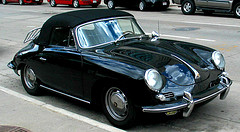Ferdinand Porsche was an automobile engineer with more than a thousand patents to his name, and played a vital role in the development of airplanes and the construction of tanks for the Wehrmacht as well. In the 1920s, he was chosen chief engineer at Mercedes-Benz in Stuttgart and later set up his own engineering workshop. Among other things, there he designed the Volkswagen. He acted as Chief of Operations at the plant where the Volkswagen was made, Wolfsburg, and at the end of the war he was jailed by the Allies.

flickr.com/csessums
He was released a few years after and immediately went to work building his first car with his son, Ferry Porsche. This car was named the Porsche 356, after Ferry, and was a sports car with styling similar to that of the Volkswagen. It had, in fact, the same four-cylinder boxer engine, and wore it rear-mounted, just as the VW did. This meant that it was far from being a great sports car, boasting a mere 40 bhp and a maximum speed of 87 mph (140 km/h).
Distinguished by its innovative and elegant body, the Porsche 356 was initially produced as a convertible and then as a hard top. Father and son expanded it in the workshop of Erwin Komenda, a master of restrained streamlining who had been in charge of sheet metal and design techniques for Ferdinand Porsche since the VW Beetle. This new design of closed coupe styled by Komenda soon became the embodiment of the sports car, due in part to its “fastback”.
Erwin Komenda and Ferdinand “Butzi” Porsche, the founder’s grandson, continued this custom with the 911.
The 911 became instantaneously recognizable: it had an attractive sloping bonnet reminiscent of the 356, what later became characterized as “frog eye” headlights, curves running from the top edge of the windscreen to the rear bumper, and a straight waistline. From a technical and functional point of view,it shared more in common with a BMW 1500, but it maintained the distinctive stylistic features of the original Porsche. The new 911 became the keystone of Porsche’s identity, even though the style was not always fully appreciated. During the 1970’s and 1980’s, many Porsche designers tried to distance Porsche from its legendary design and nearly brought the company to the edge of adversity. The more modern 924 model, “a people’s Porsche”, developed with Volkswagen, as well as the 928 fell short fulfilling expectations, and failed to allow the company to branch out in new styles and directions.
In the 1990’s, however, the company seemed to realize that what some perceived as a stylistic straitjacket was in fact a market advantage. During this period Porsche welcomed the timeless nature of classic styling to become highly profitable. Nearly forty people now worked in the design department purely dedicated to further improvement of the long running 911. Such developments included the 911 GTI, put forward by the in-house designer Anthony R. Hatter as a powerful combination of racing and sports. In 1999, Porsche’s chief designer proudly unveiled the new Boxster, enabling Porsche to prove a second independent range of successful models.
More of the World’s Top Classic Cars
Classic cars sales underway RIGHT NOW!
Tagged with: luxury car • Porsche
Filed under: Top Classic Cars